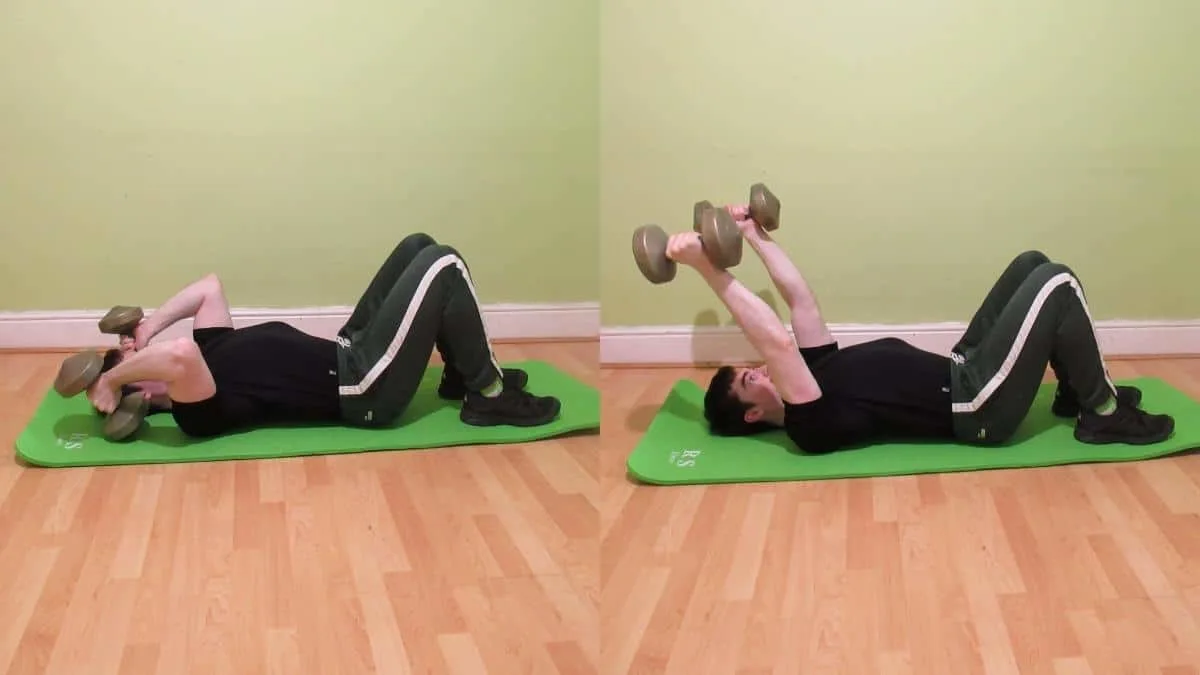Performing a skull crusher on the floor definitely has its pros and cons. On the one hand, floor skull crushers are ideal if you’re training at home and don’t have access to a weight bench—because all you need is a pair of dumbbells (or even just one dumbbell).
On the other hand, floor skull crushers are far from optimal if you have long arms because the weights will likely hit the floor before you’re able to achieve a full range of motion.
This article discusses all the pros and cons in more detail and also explains how to perform the nine different types of floor skullcrushers.
Related: Incline skull crusher
Floor skull crusher exercise details
- Also Known As: Floor tricep extension
- Main Muscles: Triceps brachii
- Exercise Type: Strength
- Exercise Mechanics: Isolation
- Difficulty Level: Beginner
- Equipment Needed: Dumbbells, exercise mat
How to do skull crushers without a bench
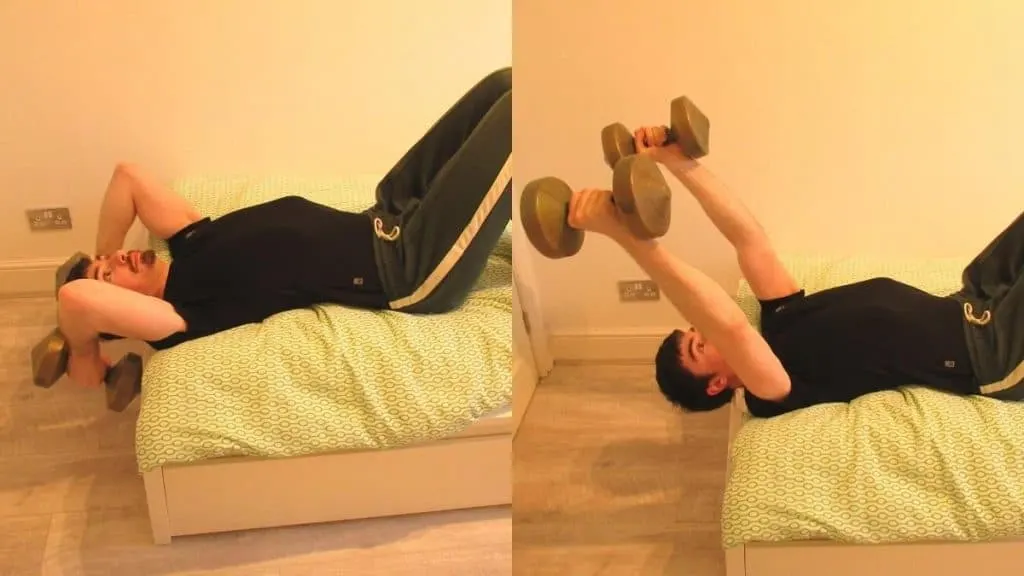
Before we get into the floor skull crusher tutorial, let’s explore the other ways that you can do skull crushers without a bench.
The first and best option is to do the DB skullcrusher off the end of your bed.
This variation works particularly well with isolateral training implements like dumbbells and kettlebells. But if you’re careful, you could also get a good workout by using a barbell.
The reason doing skull crushers on your bed works so well is because the mattress makes the exercise comfortable, thus enabling you to give your triceps maximum attention.
This is in stark contrast to performing skull crushers on the floor, which can feel quite uncomfortable unless you have a good exercise mat.
Your second option is to do skull crushers off the edge of your sofa. This variation offers all the benefits of the bed version minus (in some cases) the ability to stretch your legs out.
Depending on the size of your sofa, doing skull crushers could be really straightforward, or it could mean contorting your body into awkward positions to make the exercise work.
How to do skull crushers on the floor
- Place an exercise mat on the floor.
- Grab a pair of dumbbells with a neutral grip, and then lie on the mat.
- Press the weights up so that they’re directly over your forehead.
- Lower the weights slightly behind your head by breaking at your elbows.
- Allow some backward shoulder movement as you lower the dumbbells.
- Descend until you feel a strong stretch in your triceps.
- Reverse the motion by extending your elbows until they’re fully locked out.
- Perform 3-5 sets of 10-20 reps.
Floor skull crushers pros and cons
As mentioned, performing dumbbell skull crushers on the floor definitely has its benefits and drawbacks. So make sure to consider these pros and cons before deciding whether or not the exercise is right for you.
Pro: You don’t need a bench
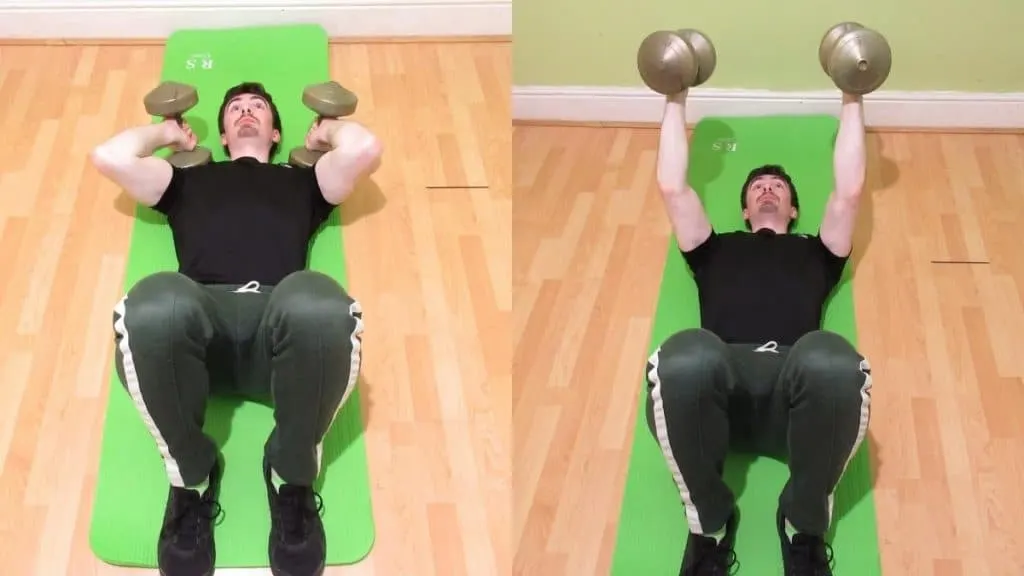
Let’s start with the obvious.
Performing skull crushers on flat ground obviously doesn’t require a weight bench.
This is ideal if you train at home and don’t have a lot of space for gym equipment or much money to buy a bench.
Floor DB skull crushers are also a good exercise for when all the benches at the gym are taken, and you don’t want to wait around for a bench to become free.
All you need to do dumbbell skull crushers without a bench is a pair of weights and a spare 5-10 minutes.
You can, of course, perform floor skullcrushers with a variety of other equipment if you don’t have access to free weights.
Pro: Trains the long head
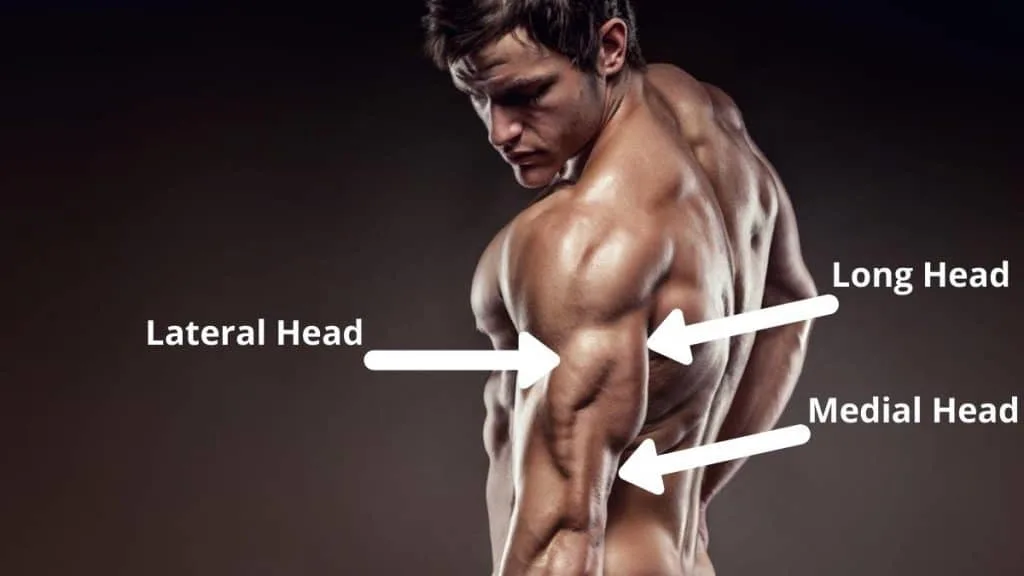
Performing skull crushers on the floor with dumbbells gives you a lot of bang for your buck.
That’s because, like dumbbell decline bench skullcrushers, floor skull crushers train all three heads of the triceps while giving special emphasis to the biggest head—the long head.
As such, the floor skullcrusher is an excellent exercise for building triceps mass with minimal equipment.
Just make sure to allow some shoulder movement back and forth as you lower and lift the weight because the long head performs shoulder extension as well as elbow extension.
And besides, performing skull crushers with stationary shoulders can put a lot of stress on your elbow joints.
Con: Arbitrary range of motion
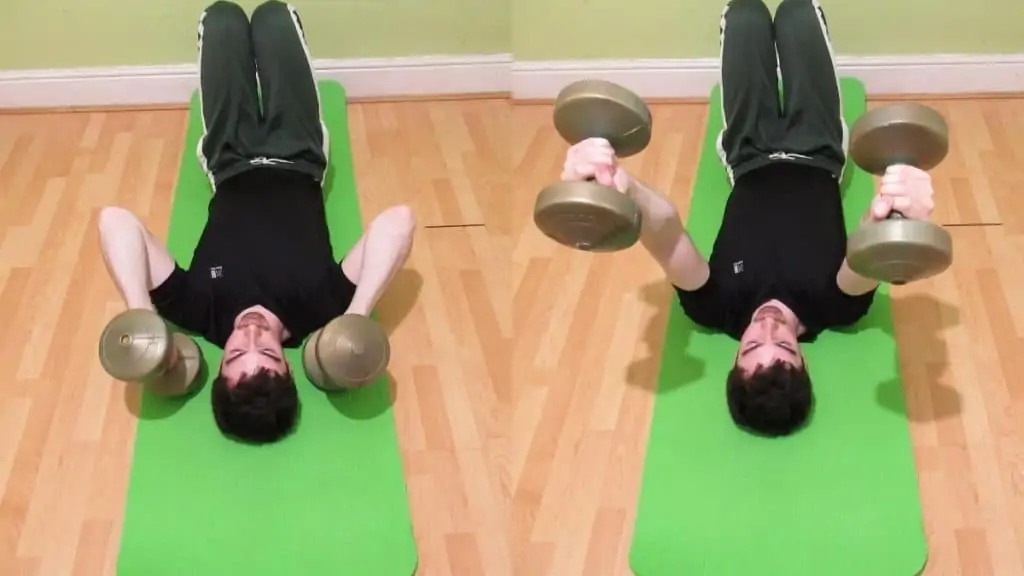
If you have long arms or good shoulder flexibility, then there’s a fair chance that you won’t be able to get a full range of motion when you’re performing ground skull crushers.
This is because the weights are naturally much closer to the floor when you’re lying on the ground, so the dumbbells might actually hit the floor before you achieve a complete triceps stretch.
You can sidestep this issue to an extent by moving your shoulders back in order to stretch the long head.
On the positive side, lowering the weight to the floor on every rep creates a standardized range of motion that you can use to gauge your progress. This helps you to ensure that you’re genuinely getting stronger as opposed to just using a smaller and smaller range of motion.
Con: May feel uncomfortable
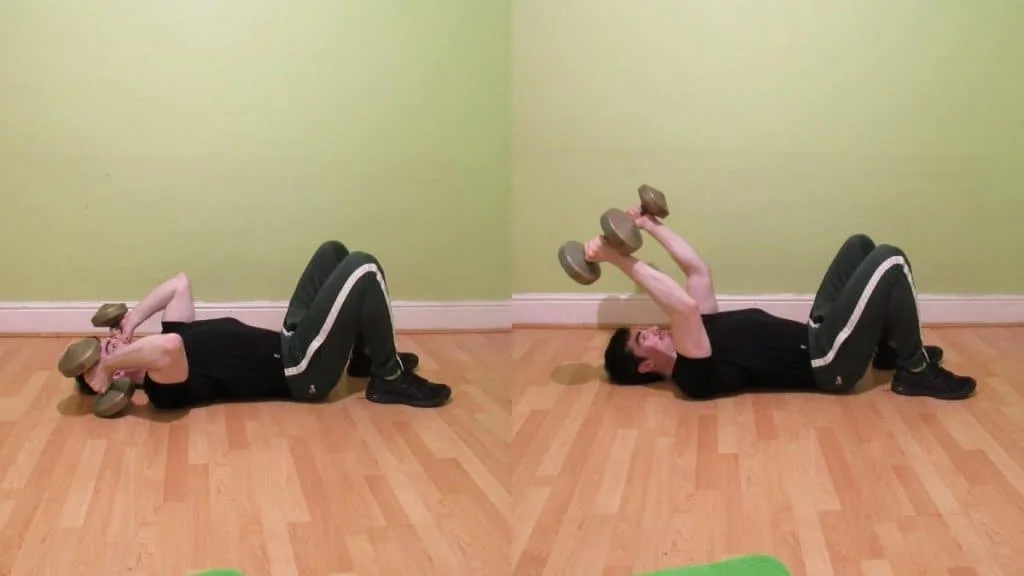
The ground skullcrusher is a great exercise—especially if you can achieve a sufficient triceps stretch.
However, unless you use an exercise mat (ideally one with plenty of padding), the movement can also feel rather uncomfortable.
This slight to moderate discomfort may well only be a small price to pay if you’re in pursuit of titanic triceps.
Yet, if you’re not so young anymore, then you may want to make your workout more comfortable by using the mat.
Floor skull crusher variations
Now that you know how to perform dumbbell skull crushers on the floor, it’s time to explore the other variations of floor crushers that you can do to train your triceps.
Barbell floor skull crusher
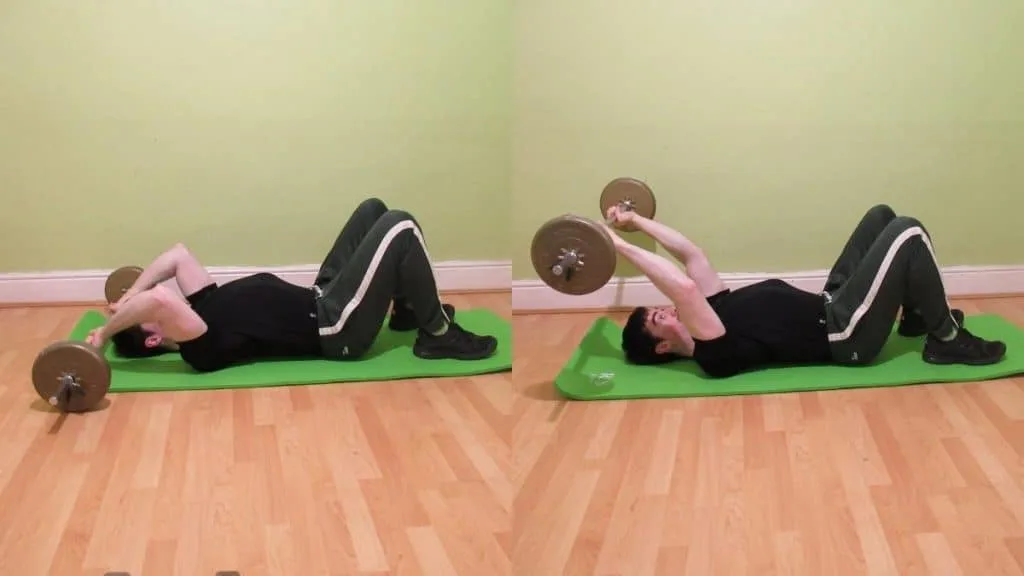
Barbell floor skull crushers are a bit of a mixed bag.
On the one hand, performing the barbell skullcrusher on the floor is a great way to overload your triceps with plenty of muscle-building resistance since barbells enable you to lift more weight than dumbbells (since they’re easier to stabilize).
On the other hand, performing the barbell floor skull crusher can put a lot of pressure on your wrists because the exercise forces your hands into a fully pronated position.
If you’re a beginner, then you might not feel any wrist discomfort initially. But as you become stronger, the admittedly unnatural (and non-negotiable) wrist position of barbell floor skull crushers will likely become more of an issue because you’ll simply be putting more torque through your wrists.
EZ bar floor skull crusher

EZ bar skull crushers are a wrist-friendly solution to barbell floor skullcrushers.
Unlike a straight bar, the EZ bar has semi-pronated grips that naturally place less stress on your wrists.
This grip, in turn, enables you to gain strength without worrying about hurting your wrists.
You’ll also be able to give more attention to training your triceps when you don’t feel any wrist discomfort.
The downside—and this is the same for the straight bar version—is that performing the floor skull crusher with a bar leaves you open to tricep size asymmetries. So just make sure that you’re not letting the bar become too lopsided if you want to sculpt symmetrical triceps.
Kettlebell floor skull crusher

Performing kettlebell skull crushers on the floor ticks virtually all of the boxes.
Kettlebells are the ideal training tool for triceps training because you have to lift each weight independently, which helps you to avoid developing muscular imbalances.
Kettlebells are also comfortable to hold despite the fact that they do force your wrists into pronation.
The only downside to the exercise is that, since kettlebells are generally bulkier than dumbbells, there’s even more chance of the kettlebells hitting the floor before you achieve a proper triceps stretch.
This may not actually be a huge issue considering that most people aren’t going to be lifting massive kettlebells for an isolation exercise like skull crushers. This is especially true given that kettlebells typically ascend in larger weight increments than dumbbells.
Cable floor skull crusher

In some gyms, it can be hard to get both a weight bench and a cable machine—by the time you wheel the bench across the weight room to the cable station, some guy has already started doing pushdowns on the machine!
As such, doing cable machine skull crushers on the floor is actually much more straightforward than the regular version in terms of setup.
You can easily move your body around on the floor to find the most comfortable position (and the one that works your triceps the best) without needing to reposition a bench.
Unlike some of the other floor skull crusher variations, the cable version also doesn’t impair your range of motion at all because you don’t typically perform cable skull crushers with huge amounts of shoulder movement.
Then there’s the constant, muscle-pumping tension that no other variation provides. So on a per rep basis, cable floor skull crushers make your triceps work harder than just about any other movement.
Resistance band floor skull crusher
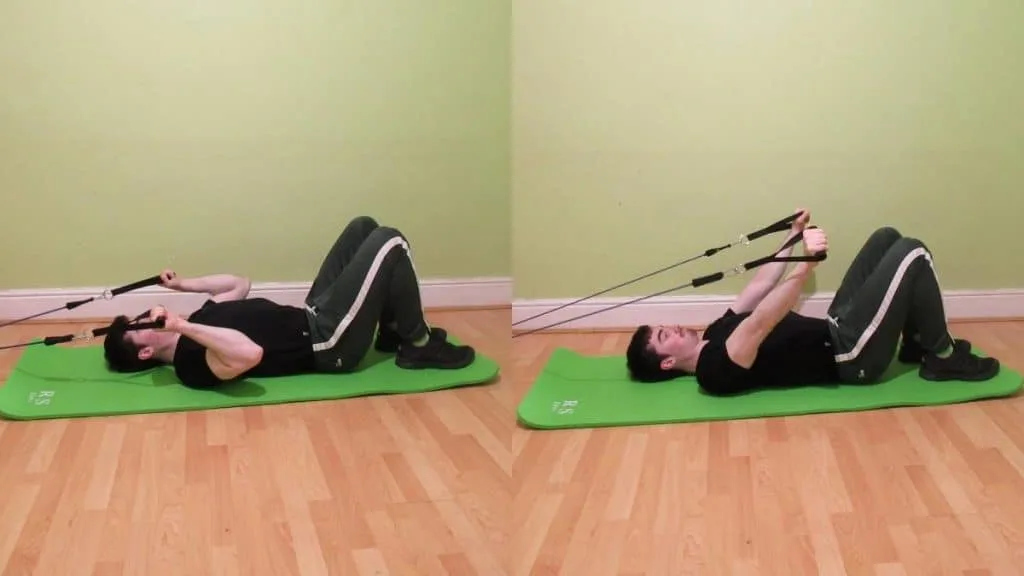
Performing skull crushers with resistance bands on the floor is a straightforward way to train your triceps when you don’t have much equipment.
You can, of course, perform band skull crushers at the gym to get a good pump and give your elbows a break from heavy free weight exercises.
Wherever you choose to do this exercise, all you need is a single band a secure anchor point.
The latter requirement is made easier by the door anchors that come with many resistance band sets these days. Door anchors save you from tying the band around the likes of a chair or table leg if you train at home.
Smith machine floor skull crusher

Doing skull crushers on a Smith machine is useful if you don’t have a spotter because you can easily hook the bar onto one of the many lookout points. And, if you have the safety stoppers activated, then you can drop the bar (or lower in gently, ideally) at any point during the rep and train your triceps to failure.
Performing a Smith machine skull crusher on the floor also means that you don’t need to waste time finding the ideal bench position.
The downside is that, on most machines, the bar path is fixed.
As such, Smith machine skull crushers can cause elbow pain for many lifters. So you should stick to high reps or just pick a different floor skull crusher variation that allows for greater freedom of movement.
Plate floor skull crushers
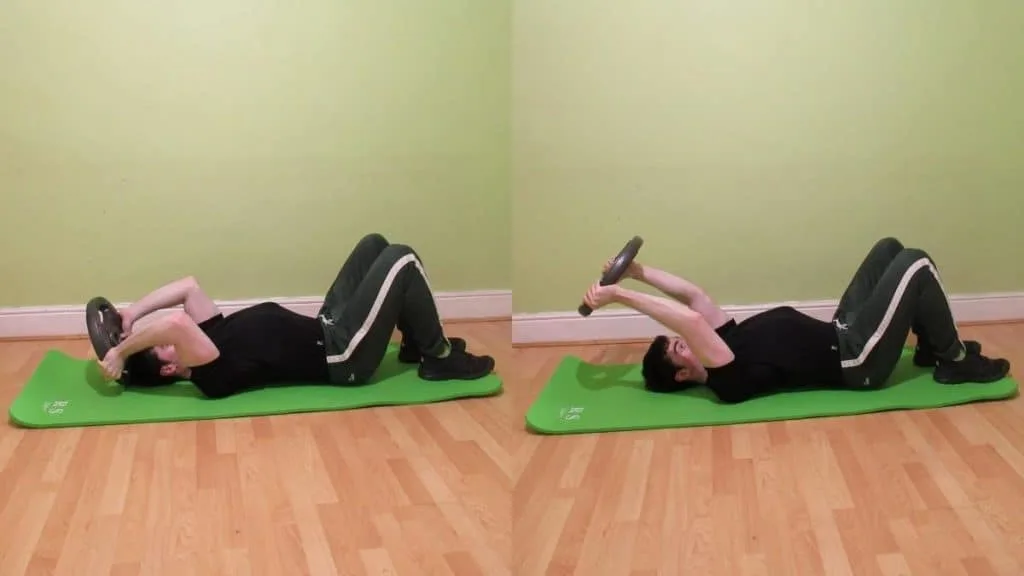
If you don’t have access to dumbbells or a bar, then you can do weight plate skull crushers on the floor with just a single weight disc.
Since you can typically hold weight plates at either side, plate floor skull crushers put your wrists in a joint-friendly neutral position that enables you to train your triceps pretty much pain-free.
Progressive overload is the only problem with plate floor skull crushers because weight discs can often have 10lb jumps between the current disc and the next one up.
You can, of course, hold multiple discs in your hands to gain strength quicker. But this approach isn’t recommended for floor skull crushers because holding multiple plates taxes your grip and thus increases the chance of you dropping the plates on your head.
You don’t want to make the movement a literal skull crusher!
One arm floor skull crusher

Performing single arm skull crushers on the floor helps you to sculpt symmetrical triceps because you need to train each arm separately.
So it’s not like your dominant arm can help out your weaker side in any way.
The only minor disadvantage is that single arm floor skull crushers aren’t ideal if you’re pressed for time because your sets will take twice as long to perform.
And after all, you could get similar mind-muscle connection and symmetry benefits by training both arms together with dumbbells.
Read More: Standing skull crushers
Conclusion: Should you do skull crushers on the floor or not?
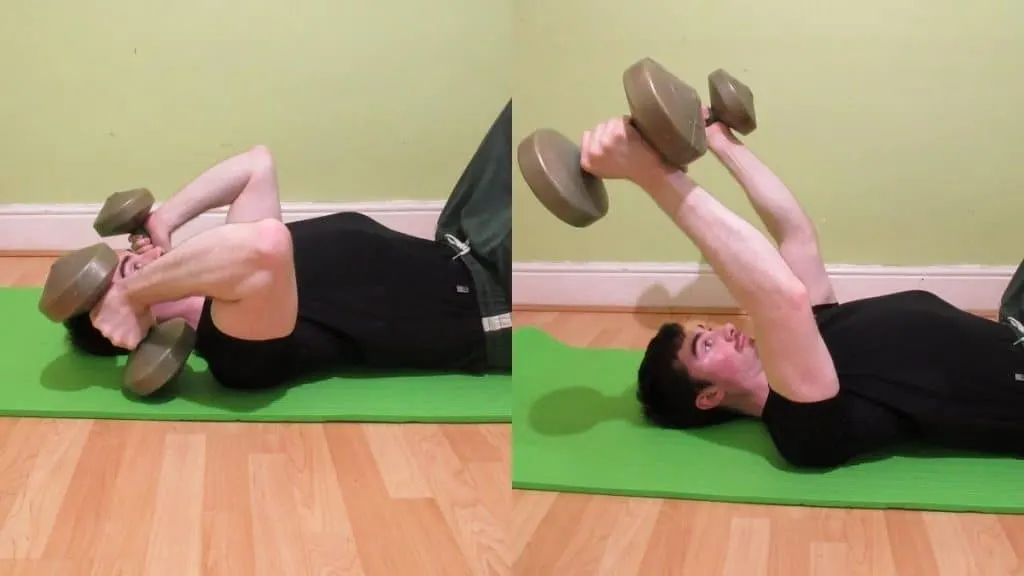
If you don’t have access to a weight bench, then floor skull crushers are your ticket to triceps growth. You can perform the exercise virtually anywhere because you only need a small pair of weights and a place to lie down (though an exercise mat would undoubtedly increase the comfort level of the exercise).
If you have particularly long arms, then you might struggle to get a full range of motion on floor skull crushers.
But just because the weights hit the ground doesn’t necessarily mean that you’re cutting off your range of motion. It’s more about the quality of the triceps stretch rather than the position of the dumbbells. So as long as you feel the long head of your triceps working, you’re making the most of the exercise.

